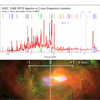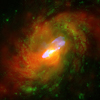CXC Home | Search | Help | Image Use Policy | Latest Images | Privacy | Accessibility | Glossary | Q&A
Animation of Changes in the X-ray Spectrum
Quicktime MPEG
This animation shows some of the detailed observations used to study the powerful winds in NGC 1068. It begins with a view of the composite image then rotates the view so that the radio jet runs from left to right. The changes in the X-ray spectrum about 3000 light years on either side of the central black hole are then shown. Detailed models applied to these data have allowed the speed and energy of the winds to be estimated.
[Runtime: 00:13]
Quicktime MPEG
This animation shows some of the detailed observations used to study the powerful winds in NGC 1068. It begins with a view of the composite image then rotates the view so that the radio jet runs from left to right. The changes in the X-ray spectrum about 3000 light years on either side of the central black hole are then shown. Detailed models applied to these data have allowed the speed and energy of the winds to be estimated.
[Runtime: 00:13]
(Credit: X-ray (NASA/CXC/MIT/C.Canizares, D.Evans et al), Optical (NASA/STScI), Radio (NSF/NRAO/VLA))
Composite Image of NGC 1068
Quicktime MPEG
This is a composite image of NGC 1068, one of the nearest and brightest galaxies containing a rapidly growing supermassive black hole. X-ray data from the Chandra X-ray Observatory are shown in red, optical data from the Hubble Space Telescope in green and radio data from the Very Large Array in blue. The spiral structure of NGC 1068 is shown by the X-ray and optical data, and a jet powered by the central supermassive black hole is shown by the radio data. The Chandra data shows evidence for powerful winds blown from the vicinity of the black hole. These winds contain enough energy to suppress new star formation in NGC 1068.
[Runtime: 00:13]
Quicktime MPEG
This is a composite image of NGC 1068, one of the nearest and brightest galaxies containing a rapidly growing supermassive black hole. X-ray data from the Chandra X-ray Observatory are shown in red, optical data from the Hubble Space Telescope in green and radio data from the Very Large Array in blue. The spiral structure of NGC 1068 is shown by the X-ray and optical data, and a jet powered by the central supermassive black hole is shown by the radio data. The Chandra data shows evidence for powerful winds blown from the vicinity of the black hole. These winds contain enough energy to suppress new star formation in NGC 1068.
[Runtime: 00:13]
(Credit: X-ray (NASA/CXC/MIT/C.Canizares, D.Evans et al), Optical (NASA/STScI), Radio (NSF/NRAO/VLA))
Return to NGC 1068 (March 3, 2010)




